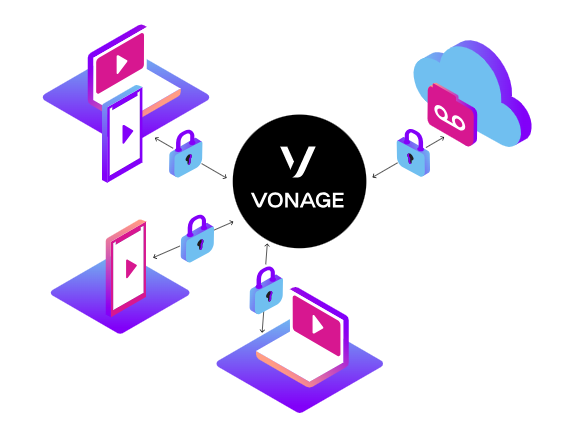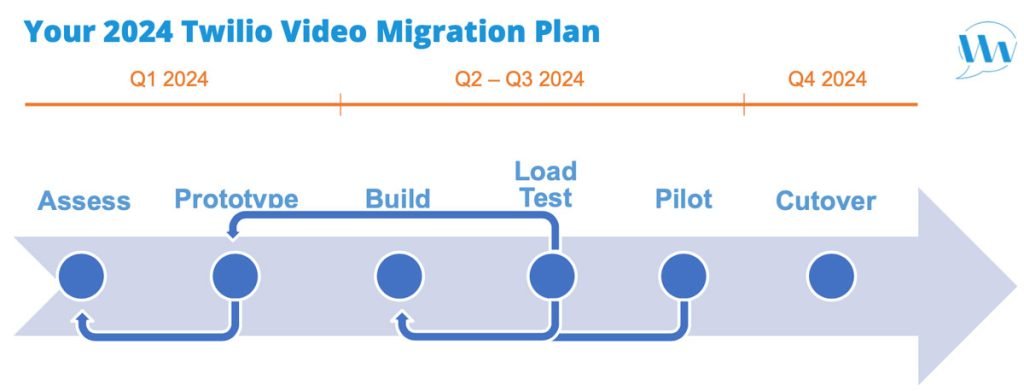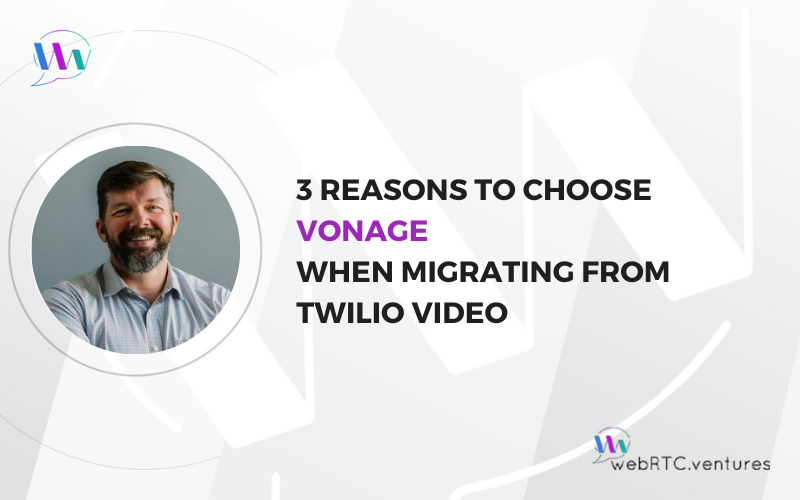Meet with our CTO to discuss your Twilio migration
Many companies are considering how to gracefully transition from Twilio Video and where to go before it sunsets in December 2024. Earlier this month, I hosted a webinar on this subject with special guests from our expert WebRTC.ventures team. You can find the webinar video and slides, links to presentation resources, and a migration plan timeline on our Migrating From Twilio Video Resource page.
There are many great Communications Platform as a Service (CPaaS) options out there to choose from – and open source media servers, as well. Today, I will review 3 reasons why you might choose Vonage when transitioning from Twilio Programmable Video.
For more information, you can also visit:
-
- Build with Vonage, the most well-established CPaaS on the market (WebRTC.ventures)
-
- Twilio to Vonage Migration Guide (developer.vonage.com)
Reason #1: Maturity
Vonage is the most well-established CPaaS out there. We have worked with them since 2015 when it was Tokbox. In fact, we were Tokbox’s first development partner. Prior to that, it was working on the OpenTok APIs that helped us decide we wanted to focus on WebRTC as a company. So we launched the WebRTC.ventures brand and we have consistently built applications with those APIs.

Our team has seen the original OpenTok APIs grow through a couple of acquisitions, and our experience as developers has never suffered. From the time they were acquired by Vonage, to now when Vonage is owned by Ericsson, we have always felt that WebRTC video was a priority for the company and that they value the developer ecosystem around it.
This is really important, because unfortunately I never had that feeling with Twilio. Twilio did a great job with messaging, but the Video product always felt like an add-on that was never given the full attention it deserved. That seems to have been the case, since Twilio decided to jettison Twilio Video when it was no longer strategic enough for them.
That is very unlikely to happen with Vonage. The Vonage Communication APIs, including Video, are all backed by Ericsson. It fits strategically with who they are and this should continue for the long term. They are not going anywhere.
In addition to stability, it’s also a very mature solution which is ready for the enterprise. Vonage offers Enterprise Support packages, in which the higher tiers include dedicated support engineers who get to know you and your product so they can provide better support and ongoing check-ins and advice.
This Enterprise Support option complements our skills nicely. By using WebRTC.ventures as your Managed Service Provider and Tier 2/Tier 3 support team, we can handle the general issues you might run into with a custom communication application. When we run into an issue that might require insider knowledge at Vonage, their Enterprise Support team will be ready to jump. A deep support team like this that is knowledgeable across your whole product stack is truly invaluable.
Reason #2: Topology and Flexibility
When I’ve spoken with Vonage reps about what makes them different, the second area they point out is the flexibility and breadth of their application topology. In other words, you can do just about anything with the Vonage APIs. As an example, here’s an (incomplete) list of the functionality available which we see most valuable:
-
- Multiple ways of routing your WebRTC traffic: Peer to Peer (P2P), routed traffic for typical 1-1 calls or larger group calls, as well as interactive broadcasting scenarios
-
- 1080p available, especially important for recording & broadcast scenarios and something not offered by Zoom
-
- Broadcasting features equivalent to Twilio Live, which can make that migration easier
-
- Flexible recording composition engines. Many video recording solutions give you only a single recording layout option (i.e., all video feeds of equal size and laid out in a grid). Vonage offers the ability to choose how you compose (or layout) your recordings. This provides more flexibility to highlight certain speakers or screen shares, depending on your use case.
-
- SIP video & audio integration, so that you can integrate WebRTC into your contact center
-
- Individual streams of video and audio are available, important for integration with third party AI/ML services.
Reason #3: Security and Compliance
The final area to call out is security and compliance, which is to be expected when you have a platform with the longevity and maturity of Vonage. The Vonage team has experience working with Healthcare and FinTech services in the EU and the US, which means they can support you in meeting all the typical security and compliance requirements your organization may have.

Here’s a few other features to call out specifically around security and compliance:
-
- Recordings can be encrypted at rest
-
- Regional media zones to isolate all media
-
- Deploy your own TURN servers optionally
-
- Experience working with Healthcare/Financial Services to EU and US standards
-
- End to End Encryption (E2EE) available (though note that use of E2EE with any CPaaS can restrict features such as recording that require an intermediary media server)
Bonus Reason: Vonage is more than just WebRTC!
One of the attractive features of Twilio was the breadth of services they offer. Voice, SMS and Messaging is how they made their name. Over the years they added in many other services, some of which were rolled back. Video is case in point.
Vonage has a similar advantage to Twilio in the marketplace, but with a stronger financial backing and more longevity. Through acquisition and growth over the years, Vonage has assembled an impressive range of communication services, including:
Vonage is a great choice to consider because it offers a wide range of services on a stable platform. For larger clients, you can also work directly with their sales team on pricing that makes the most sense for your use case, and we can certainly put you in touch with the right people to discuss those matters.
All of this means that if you choose to use Vonage to replace Twilio Video, you can choose to use more than just the Vonage Video APIs. You can look at upgrades and new feature additions to your application across the communications and AI stack!
Your 2024 Twilio Video Migration Plan
It was good that Twilio gave everyone a full year to migrate their applications. December 5, 2024 will come up faster than you expect! Based on our experience building live video and communication applications for nearly a decade for a wide range of industries and use cases, we know that building, deploying and testing these applications is often harder than people expect.
Below is our recommendation for your 2024 migration timeline, assuming that you are reading this in Q1 of 2024. If you are reading this later than that, then it’s even more critical that you contact us today so you have enough time to do a high quality cutover.

A successful migration away from Twilio Video should leave enough room for each of these steps:
-
- Assess
Take some time to compare not just features, but also billing models and technical implementations. We can help you compare multiple architectural considerations.
-
- Prototype
Every CPaaS implements a few things differently, even when the APIs look similar. You’ll want to prototype your new solution to discover the little things that may have a big impact on your specific workflow. We strongly recommend that you complete the Assessment and Prototyping phases in Q1 2024 in order to leave plenty of time for the hard work that follows.
-
- Build, Load Test, and Pilot!
After a successful prototype, you obviously need to do the full integration of your new media API into your application. Don’t forget to load test this new implementation and then pilot it with Alpha and Beta users to ensure it performs the way you expect both technically and from a usability perspective. Ideally, you’ll have all of Q2 and Q3 to dedicate to these efforts, so that you can deploy early and confidently in Q4. Make sure you start your pilot well before Q4 though so that you have time to incorporate feedback from users and load testing!
-
- Cutover
If you started early enough, we recommend doing your deployment early in Q4 2024. Don’t wait until December. Leaving some time allows a temporary rollback, if needed. You will also have better access to the support resources of your new CPaaS, our team, and even Twilio if needed, well before the rush of cutovers in November and December 2024 for those who didn’t get started early.
Don’t get caught at the back of the line!
We expect high demand for our team’s expertise this year. It’s crucial to contact us promptly to secure a slot for your project. Whether you’re seeking consulting and assessment exclusively or require assistance with the complete migration, deployment, and support of your new solution, we’re here to assist. Don’t hesitate—contact us today.











